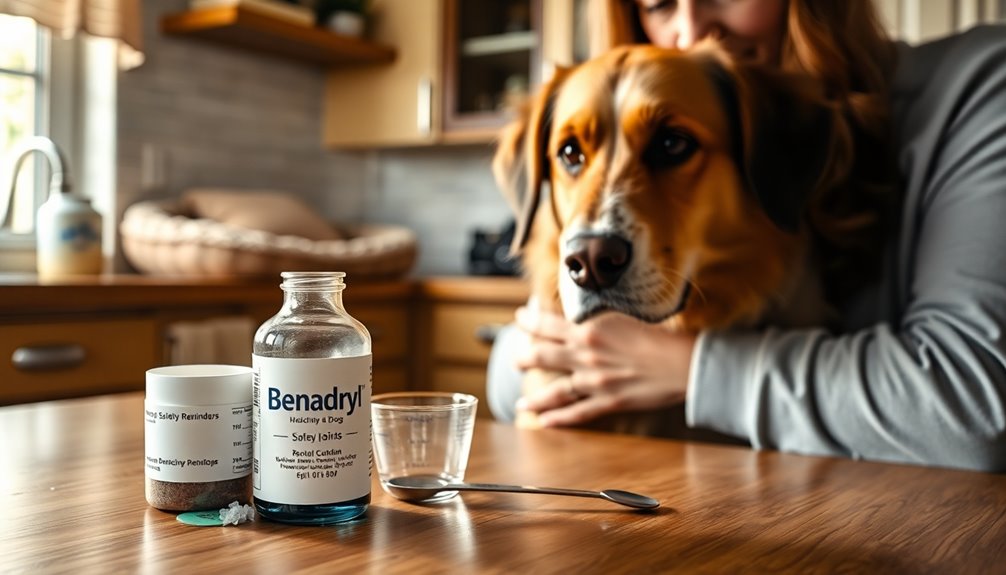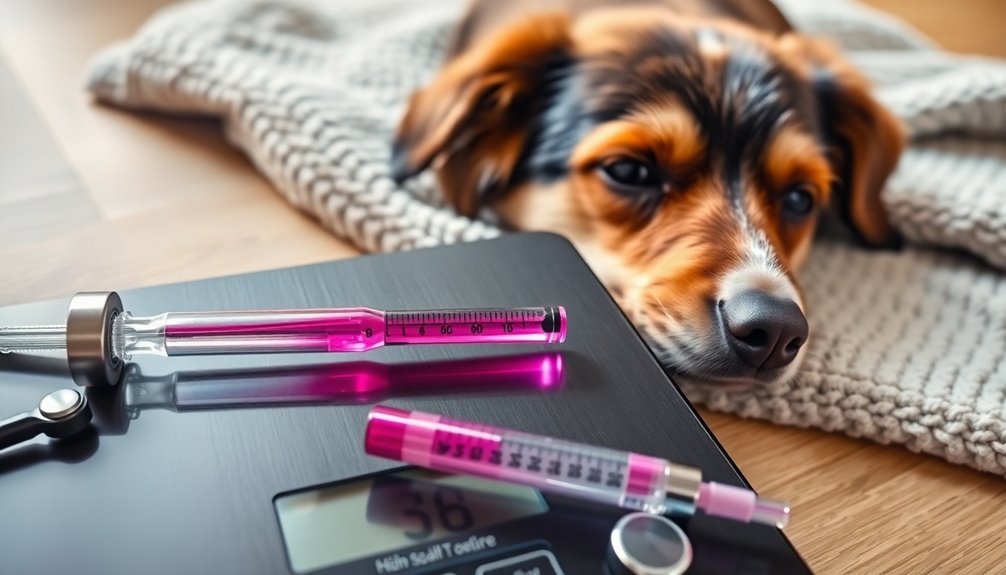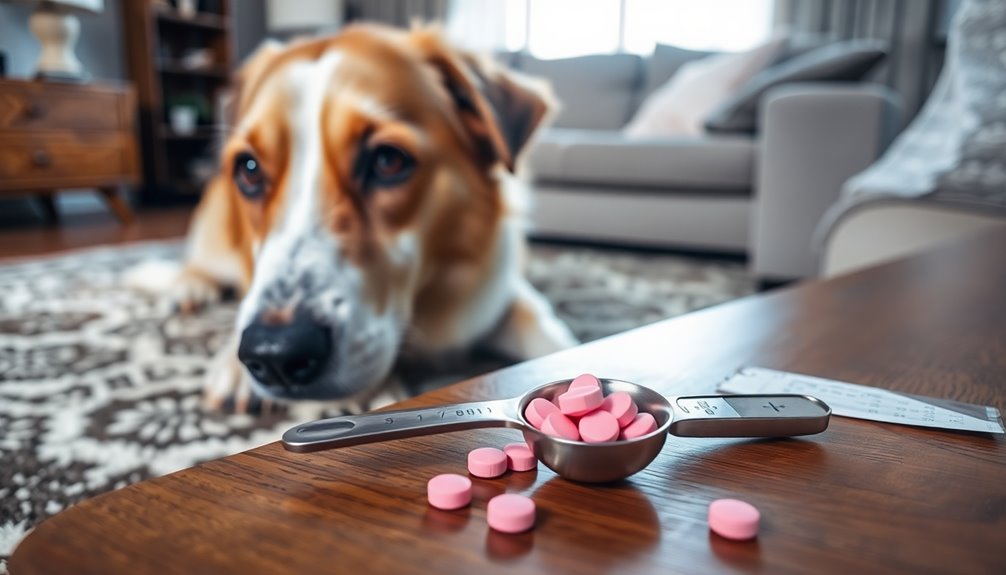If you've got a 50 lb dog, the accurate Benadryl dosage is around 50 mg. This helps alleviate allergy symptoms and can ease anxiety during stressful situations. You can give it to your dog 2 to 3 times daily, depending on their symptoms. Always choose Benadryl containing only diphenhydramine and avoid any harmful additives. Before you administer it, be sure to check with your veterinarian, especially if your dog has any health issues. Keep an eye on how they react after taking it, as monitoring is key for their well-being. There's more essential info to guide you further.
Key Takeaways
- The recommended dosage of Benadryl for a 50 lb dog is approximately 50 mg, based on 1 mg per pound of body weight.
- Administer Benadryl 2 to 3 times daily as needed, keeping symptoms in mind.
- Always consult with a veterinarian before giving Benadryl to ensure safe dosage and suitability for your dog's health status.
- Choose formulations containing only diphenhydramine without harmful additives to avoid adverse effects.
- Monitor your dog for side effects like drowsiness or unusual behavior, and seek veterinary help for severe reactions.
Overview of Benadryl

When your dog is dealing with allergies, Benadryl can be a helpful option. This over-the-counter antihistamine, containing diphenhydramine, effectively blocks H-1 receptors to prevent allergic reactions, alleviating symptoms like itching, sneezing, and coughing.
Benadryl is available in tablets, capsules, and liquid forms, providing flexible dosing options tailored to your dog's needs. The typical dosing guideline is 1 mg per pound of body weight, so for a 50 lb dog, you'd give about 50 mg.
However, it's essential to consult your veterinarian before administering this medication, especially if your dog has pre-existing health conditions or is on other medications. While Benadryl is generally considered safe, be aware of potential side effects and always prioritize your dog's health.
Uses of Benadryl for Dogs

Benadryl is a versatile tool for managing various issues in dogs. This antihistamine effectively alleviates mild allergic reactions caused by environmental allergies, such as pollen or insect bites.
If your dog experiences nausea during travel, Benadryl can help prevent motion sickness, making trips more comfortable. Additionally, it may ease mild anxiety in stressful situations, like visits to the veterinarian or fireworks.
However, it's essential to consult your veterinarian before giving Benadryl, as the correct dosage depends on your dog's weight and health conditions.
Keep in mind that while it's generally safe, side effects like drowsiness or dry mouth can occur. Always prioritize your dog's well-being when considering Benadryl for these situations.
Safety Considerations

Administering Benadryl to your dog requires careful consideration of safety. Before you give any dosage, it's vital to consult with a veterinarian to guarantee it's appropriate for your dog's specific health conditions.
Monitor your dog closely for potential side effects like drowsiness, dry mouth, or hyperactivity, as reactions to diphenhydramine can differ from one dog to another.
Avoid giving Benadryl to dogs with existing health issues, such as glaucoma, cardiovascular disease, or urinary retention, since it may worsen these conditions.
Always choose formulations containing only diphenhydramine, steering clear of added ingredients like alcohol or xylitol, which can be harmful.
Prioritizing safety guarantees your dog receives the best care possible while using Benadryl.
Recommended Dosage for 50 Lb Dog

For a 50 lb dog, the recommended dosage of Benadryl is about 50 mg, which translates to roughly 1 mg per pound of body weight.
You can administer this dosage 2 to 3 times daily, depending on your dog's symptoms.
Benadryl comes in 25 mg and 50 mg tablets, so your 50 lb dog may need 2 tablets of the 25 mg formulation or 1 tablet of the 50 mg formulation per dose.
It's essential to consult with a veterinarian before giving Benadryl, as they can advise on the appropriate dosage based on your dog's health status and any medications they might be taking.
Dosage adjustments may be necessary for dogs with pre-existing conditions.
Potential Side Effects

When giving your dog Benadryl, it's important to be aware of potential side effects that may arise. Common side effects include drowsiness, dry mouth, and increased heart rate.
You might also notice less frequent issues like vomiting, diarrhea, or hypersalivation. Some dogs, particularly older or medicated ones, may experience urinary retention.
While severe adverse reactions are rare, they can include difficulty breathing and high blood pressure, requiring immediate veterinary attention.
To guarantee your dog's safety, monitoring for side effects is vital, especially when administering Benadryl for the first time or if your dog has pre-existing health conditions.
Keep a close eye on your furry friend and consult your vet if you notice anything concerning.
Alternatives to Benadryl

While Benadryl can be effective for alleviating allergies in dogs, there are several alternatives you might consider:
- Zyrtec (Cetirizine) – Typically dosed at 0.5 mg per pound of body weight.
- Claritin (Loratadine) – Recommended dosage is 0.2 mg per pound.
- Natural Remedies – Options like Quercetin, Omega-3 fatty acids, and calming supplements can help without the side effects of antihistamines. Certain teas may also have calming effects, which can complement natural remedies.
For severe allergies, prescription medications such as corticosteroids may be more effective.
You can also explore behavioral modification and environmental management to reduce anxiety in your dog.
Always consult a veterinarian before starting any alternative treatments to verify they're safe and appropriate for your dog's specific health needs.
Veterinary Consultation Importance

Before giving your dog Benadryl, it's crucial to consult with a veterinarian.
They can help you avoid the risk of misdiagnosis and guarantee any treatment plan is tailored to your dog's specific health needs.
This way, you can address the root cause of your dog's issues effectively and safely.
Risk of Misdiagnosis
Misdiagnosing your dog's symptoms can lead to improper treatment with Benadryl, which might worsen underlying health issues if the actual cause isn't addressed.
That's why a veterinary consultation is essential before you administer any medication.
Here are three key reasons to seek veterinary advice:
- Accurate Diagnosis: Allergy symptoms can mimic other health conditions, like infections or autoimmune diseases.
- Safe Use: Understanding your dog's medical history guarantees safe dosing based on body weight and prevents drug interactions.
- Preventing Adverse Effects: Misdiagnosis can lead to incorrect dosing of Benadryl, increasing the risk of adverse effects. Additionally, a lack of empathy and support from the owner can affect the dog's recovery process.
Always prioritize your dog's health by consulting a vet to guarantee proper treatment and avoid complications.
Individual Health Assessment
Ensuring your dog receives the right treatment starts with an individual health assessment from a veterinarian. A veterinary consultation is vital before giving Benadryl, especially if your dog has pre-existing health conditions or is on other medications.
Individual health assessments can identify issues like cardiovascular disease or liver problems that might impact how your dog tolerates Benadryl. Your vet will provide dosing recommendations based on your dog's weight and health status, ensuring safe use for specific allergy symptoms.
Additionally, monitoring your dog's response is essential to detect any adverse reactions or side effects during treatment. Regular check-ups help track overall health and allow timely adjustments to allergy treatment plans, including medication like Benadryl.
Tailored Treatment Recommendations
While it might be tempting to give your dog Benadryl without consulting a vet, doing so can lead to unintended consequences. Here are three reasons why a veterinarian consultation is crucial:
- Accurate Dosing Guide: The appropriate Benadryl dosage for dogs varies; a 50 lb dog typically needs 25-50 mg of diphenhydramine.
- Health Conditions: A vet can identify potential health conditions that may contraindicate antihistamine use, guaranteeing your pup's safety.
- Monitor Reactions: Regular follow-ups help monitor side effects or adverse reactions, especially in dogs with existing health issues. Understanding the importance of emotional regulation in pets can also aid in assessing their overall well-being.
Tailored treatment recommendations from a veterinarian guarantee you give the right dosage while avoiding harmful additives, making your dog's safety a top priority.
Monitoring Your Dog's Reaction

After you give your dog Benadryl, it's crucial to closely monitor their behavior for any signs of drowsiness, hyperactivity, or unusual reactions.
Watch for common side effects like dry mouth, increased heart rate, or urinary retention, which may require veterinary intervention if they worsen. Document any changes in your dog's behavior, both good and bad, to provide your vet with thorough information during future visits.
If your dog shows signs of an allergic reaction—like difficulty breathing, swelling, or hives—seek immediate veterinary care; Benadryl isn't a substitute for emergency treatment.
Always check the recommended dosage and confirm any adjustments for health conditions or other medications with your veterinarian to minimize risks.
Frequently Asked Questions
How Much Benadryl for a 50 Pound Dog?
When you're considering how much Benadryl to give a 50-pound dog, aim for a dosage between 25 mg and 50 mg.
That's roughly 1 mg per pound, so one or two 25 mg tablets should work. You can administer this up to three times a day, but check with your vet first.
Always keep an eye on your dog for any side effects like drowsiness or hyperactivity after giving the medication.
How Much Benadryl Can I Give My Dog Calculator?
To calculate how much Benadryl you can give your dog, you need to know their weight in pounds.
A general guideline is 1 mg per pound, but you can also refer to a dosage calculator for more precision.
Keep in mind the recommended range is typically 2-4 mg per kg of body weight.
Always consult your veterinarian before giving Benadryl to guarantee it's safe and appropriate for your dog's health needs.
Is There a Difference Between Human Benadryl and Dog Benadryl?
You know what they say, "Better safe than sorry."
When it comes to Benadryl, there's definitely a difference between the human and dog versions. While both contain diphenhydramine, human formulations often include harmful additives or alcohol, which aren't safe for dogs.
Always check labels carefully, and consult your vet before giving any medication to your furry friend. It's essential to guarantee their safety above all else!
Is 25MG of Benadryl Too Much for a Dog?
If you're wondering whether 25 mg of Benadryl is too much for your dog, it typically isn't, especially for a 50 lb dog.
This dose falls within the safe range, generally recommended at about 1 mg per pound of body weight.
However, it's essential to consult with your veterinarian before administering any medication. They can provide guidance tailored to your dog's health needs, ensuring their safety and well-being.
Always monitor for side effects, too.
Conclusion
In summary, when it comes to giving Benadryl to your 50 lb dog, it's essential to stick to the recommended dosage and keep an eye on how they react. Remember, a little caution goes a long way! If you notice any side effects or have concerns, don't hesitate to consult your vet. Keeping your furry friend happy and healthy is the name of the game, so always prioritize their well-being over anything else.










